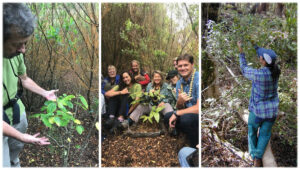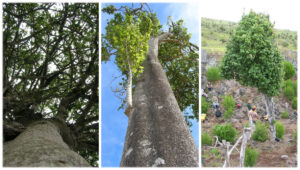
A forest is a vast inter-connected ecosystem, much more than just the trees.
It’s a complex world filled with diverse civilizations of microscopic creatures all the way up to the towering trees. And it includes all the animal and bird life living symbiotically with the trees and with all the extraordinary life that exists under the trees’ umbrella.
The forest is magical and mysterious. It is home to thousands of creatures. The tall trees fill us with joy, seeing their distant limbs up high, swaying in the tropical trade winds. Below, the ferns and small bushes fill us with the wonder of a world where everything is incredibly and beautifully perfect.
This perfection is only magnified once you enter the Auwahi Reforestation reserve.
Immediately you begin to see and feel an ancient forest being reborn. Beside your feet, the smallest of seedlings breaks through the newly forming forest floor. Looking outside the reforestation enclosure, you are surrounded by a desolate landscape of pasture land high up on the leeward side of the Haleakalā volcano.

The only sounds to be heard here are the trade-wind breezes coming through the young native trees and bushes. Plus, the soft hum of your fellow volunteers quietly digging, weeding, collecting seed, or strategizing what’s next in low whispers.
It is like we are participating in a sacred rite.
It may be that you like the idea of traveling up to this remote spot with a group of generally quiet, plant-loving people. Or, the opportunity to be part of a rare event appeals to you – the re-birthing of a 98% extinct, dry-land forest on Maui. Finally, perhaps you want to see and do something completely different on your next visit to Maui.
Well, if what you have read so far intrigues you, then the rest of this blog will totally excite you!
First, what is a day of volunteering at Auwahi like?
First, you contact the organizers to get a spot in one of the 4-wheel drive vehicles. Then, you will meet the gang at 8:00AM at the ‘Ulupalakua Ranch Store. You will clean any invasive seeds off your hiking boots and clothes before you pile in the vehicles.
After cruising down the 2-lane highway a few miles towards Kipahulu/Hana, it’s time to go off-road on the ‘Ulupalakua Ranch jeep trails up to the reforestation site.

Upon arrival, you meet the Project Founder and Director, Art Meideros, Ph.D. He will speak to everyone about the day’s activities. He doesn’t hold back his enthusiasm for the project, and you will feel super inspired before you even lift a pick-axe or plant an endangered plant into its little puka or hole.
Two or three hours will pass by in a flash of excitement and awe as you realize what a unique and special mission you and your group are on.
Dr. Medeiros will make sure you catch the excitement!
About the time you start feeling hungry, it’s time for lunch. Everyone will find a soft spot to sit in the adjoining pasture and have lunch.
Lunch is my favorite time because it’s storytelling and question time. Maybe someone will tell a story about when Paul Simon (who lives part-time on Maui) played to a packed concert amphitheater to benefit the reforestation project.

This story started when Paul went to see one of the last two Kanaloa plants alive. It was at Anna Palomino’s native plant nursery called Ho’olawa Farms. After expressing interest in conservation, Anna, whose nursery has supported reforestation on Maui for years, put him in touch with Art.
Not long after meeting Art, he put on the benefit concert on Maui and donated half the gate receipts ($1.1 million) to Auwahi. The other half went to Kua’aina Ulu ‘Auamo, a natural resource management organization on Maui.
A few days after the concert, Paul came to Auwahi for a planting ceremony for a Lama tree. Afterward, he said:
“To even sit with you guys and be in the same community is such a privilege.”

The lunchtime questions and stories may include a question about how the native dry-land forests disappeared. And then, you will hear about over harvesting, the introduction of the dreadfully invasive Kikuyu Grass from Africa, and finally, the roll of cows eating all the fresh tree seedlings as they self-propagated.
After lunch and the Talk Story break, you may work another hour or so. You may be collecting seeds, which is a massive part of reforestation. They will be used in one of the volunteer nurseries to start the seedlings for the next visit. Another essential job you may have is weeding out invasive, non-native species to keep them from multiplying in the reserve area.
Who will you go with?
The people you will join on this project will be diverse, vibrant, active, and multi-generational. I mean, Paul Simon is 79 years old!. As long as you are in good physical shape for rocky, off-trail walking, going up medium steep slopes, you are golden.
The number of volunteers depends entirely on how many 4-wheel, high clearance trucks and SUVs. So, don’t be too disappointed if you don’t get on the next trip out. But it is good to plan ahead and keep trying.
Trees which were around during the time of Captain Cook.
When you arrive, let the awe-inspiring concept seep into you. The handful of large, surviving trees you see here and there standing alone in the pasture were once trees of a majestic forest.

Once upon a time, these same large trees heard the Hawaiian language spoken by villagers who lived in this area. Many of these same trees were here when Captain Cook’s ships passed by to the south in 1778.
It is mind-boggling. Just think, the plant you place lovingly into its awaiting home will be around several hundred years from now in a thriving native forest.

Maybe by then, Hawaiian will once again be spoken by folks living in this very same area of restored native forest.
If you love the outdoors, the mountains, the land, and digging into the earth, this is an experience you will probably never forget. Art Medeiros will leave you with so much inspiration you will want to return as soon as possible to be part of this epic project again!
At least you will have enjoyed this story and the project involved. It’s good to know that Aloha lives on in the people and plants of Hawai’i.
Writing by Peter D. Black
Graphic Design by Sugandha Ferro Black
Photos courtesy of paid for or free sources unless otherwise noted.
Art with Tree | © CC BY-ND 2.0 ADRProject/flickr, Many Hands, Smiling group | © CC BY-ND 2.0 ADRProject/flickr
All Others | © CC BY 2.0 Forest and Kim Starr /flickr